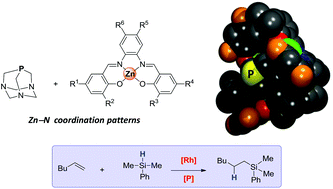The use of the com. available, bifunctional phosphine 1,3,5-triaza-7-phosphaadamantane (abbreviated as PN3) in conjunction with a series of Zn(salphen) complexes leads to sterically encumbered phosphine ligands as a result of (reversible) coordinative Zn-N interactions. The solid state and soln. phase behavior of these supramol. ligand systems have been investigated in detail and revealed their stoichiometries in the solid state obsd. by X-ray crystallog., and those detd. in soln. by NMR and UV-Vis spectroscopy. Also, upon application of these supramol. bulky phosphines in hydrosilylation catalysis employing 1-hexene as a substrate, the catalysis data infer the presence of an active Rh species with two coordinated, bulky PN3/Zn(salphen) assembly units having a max. of three Zn(salphen)s assocd. per PN3 scaffold, with an excess of bulky phosphines hardly affecting the overall activity.
